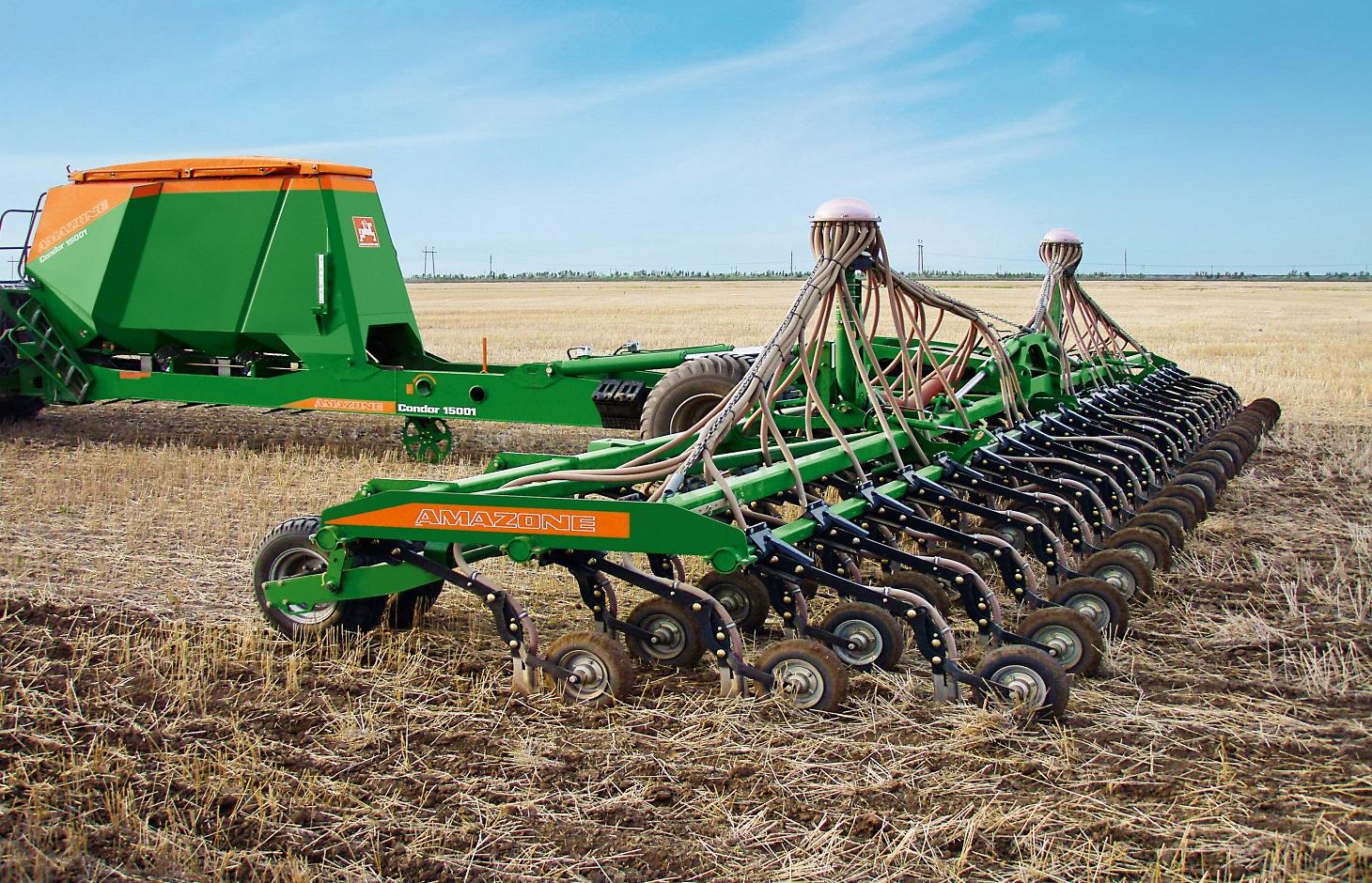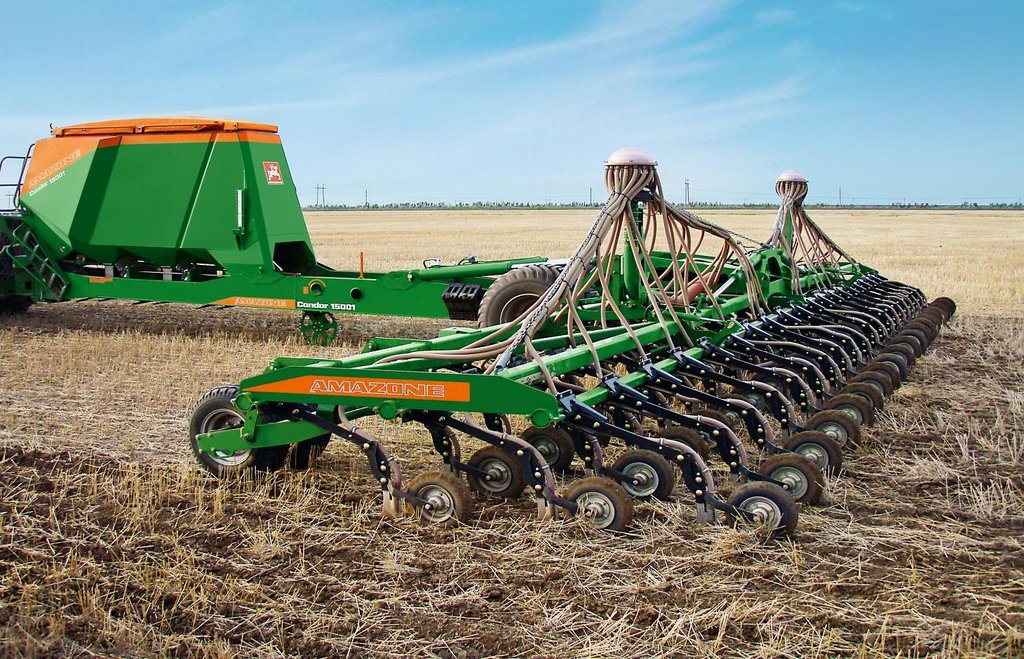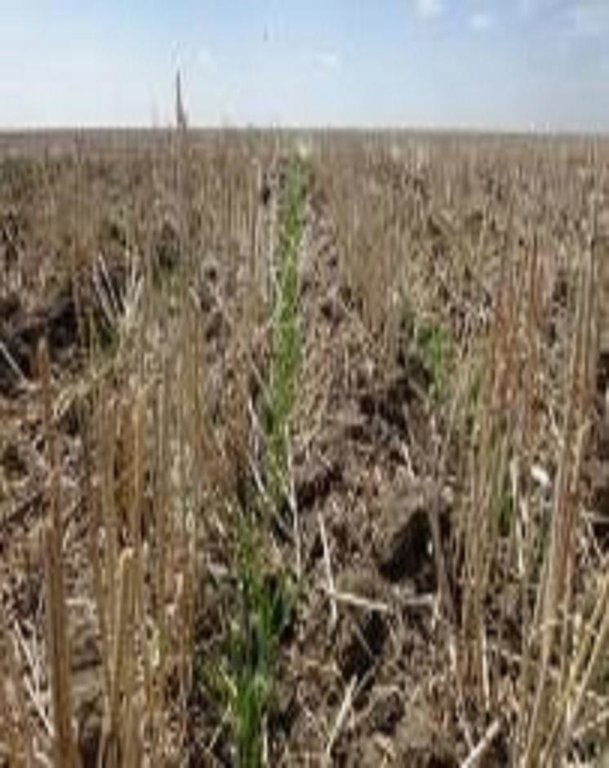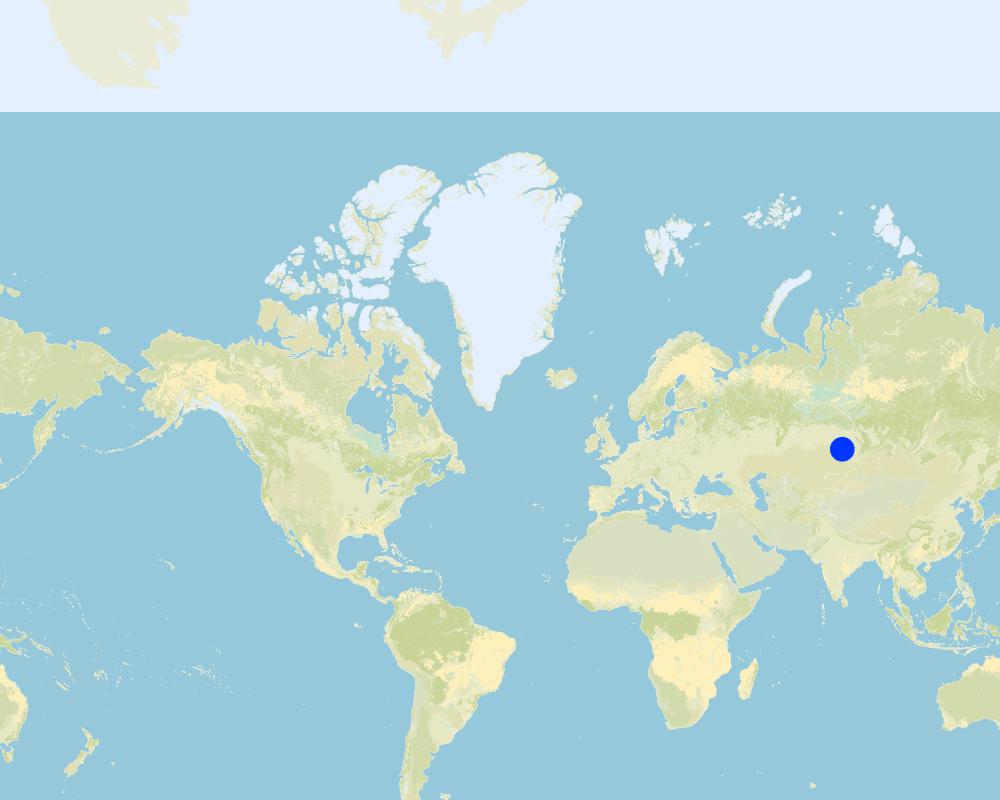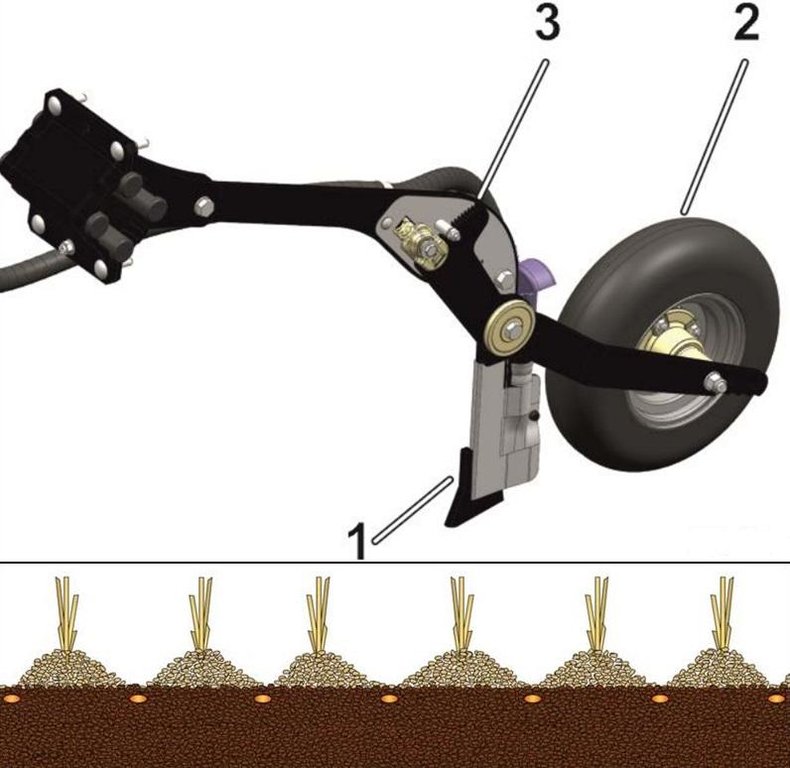No Till [Federação Russa]
- Criação:
- Atualização:
- Compilador/a: Peter Liebelt
- Editor: –
- Revisores: Alexandra Gavilano, Deborah Niggli, David Streiff
Нулевая обработка
technologies_1319 - Federação Russa
Veja as seções
Expandir tudo Recolher tudo1. Informação geral
1.2 Detalhes do contato das pessoas capacitadas e instituições envolvidas na avaliação e documentação da tecnologia
Nome do projeto que facilitou a documentação/avaliação da Tecnologia (se relevante)
Book project: Making sense of research for sustainable land management (GLUES)Nome do projeto que facilitou a documentação/avaliação da Tecnologia (se relevante)
Sustainable land management in the Russian steppes (KULUNDA / GLUES)1.3 Condições em relação ao uso da informação documentada através de WOCAT
O/a compilador/a e a(s) pessoa(s) capacitada(s) aceitam as condições relativas ao uso de dados documentados através da WOCAT:
Sim
1.4 Declaração de sustentabilidade da tecnologia descrita
A tecnologia descrita aqui é problemática em relação a degradação da terra de forma que não pode ser declarada uma tecnologia de gestão sustentável de terra?
Não
2. Descrição da tecnologia de GST
2.1 Descrição curta da tecnologia
Definição da tecnologia:
No tillage is based on direct seeding with the innovative/ modern direct seeder Condor and works without any kind of soil disturbance.
2.2 Descrição detalhada da tecnologia
Descrição:
"No-Till" is a key element of the ‘modern cropping system/ Canadian System’ in the Kulunda steppe. In contrast to minimum tillage an innovative modern direct seeding machine is used. The successful implementation of “No-Till” requires an adaptation of the whole cropping system including crop rotation. Rotation includes a succession of cereal crops (e.g. spring wheat), legumes (peas), and oil seed crops. In the study area predominantly spring cereals are grown. The direct seeder ‘Condor tine seeder’ (Amazone) was used for direct seeding. In contrast to the SZS 2.1 seeder used for minimum tillage it has flexible, individually depth-guided tine coulters, which ensure a high precision of seed placement. When opening the seed furrow, the narrow coulter moves little soil, so that the valuable soil moisture remains in the soil, and there is sufficient fine soil to ensure the optimum seed/ soil contact. Straw is safely cleared from the seed furrow, preventing the "hairpinning-effect" which is the pressing of straw by the coulter into the sowing slit. During the sowing period fertilizers are applied and broad spectrum herbicide in autumn and selective pesticides in the growing season are sprayed which help to increase yield.
No-till works without intensive primary tillage and stubble cultivation that saves time, fuel and reduces soil water evaporation. No-till increases soil aggregate stability, helps to reduce the risk of soil erosion, leads to a higher soil fertility and reduces soil water losses. Weed control through crop rotation and herbicide application allows to omit mechanical weeding and thus to protect the soil against fertility decline and soil water loss. Fertilization becomes more important, because of the decreased mineralization rate under no soil tillage, especially at the beginning of the conversion of the cropping system and until soil organic matter could build up in the soil.
The Technology including crop rotation was tested in the field in 4 test plots with 4 repetitions at the test site in Poluyamki. Results showed that the intensity of soil tillage and seeding methods used had a great influence on crop establishment and expected yields. It was demonstrated that no tillage leads to higher water use efficiency and highest yields. Positive effects were also observed regarding soil structure and soil fertility already after 3 years. Positive effects were also observed regarding soil structure and soil fertility already after 3 years. Minimized soil disturbance led to higher aggregate stability, which leads to a lower risk of wind erosion, increased soil organic carbon storage and soil fertility as well as available soil water content. The Modern Canadian system caused fixed production costs in form of annual depreciation and also additional costs due to the application of fertilizers and pesticides, the prices of which increased in the last four years. Due to not finalised land rights reforms, uncertain credits and harvest insurance farmers are reluctant to invest in new machines.
The test site in Poluyamki is located in the dry steppe of the border region next to Kazakhstan, where, due to the climatic conditions, no natural afforestation occurs, and the planted windbreaks don’t grow vigorously due to the prevailing aridity. The annual precipitation is under 300 mm a year. Probably the greatest climatic influence factor is the precipitation - in terms of quantity and space/ time distribution and, due to high summer temperatures, the high rates of evapotranspiration. The total yearly precipitation rate is the primary yield-limiting factor in all steppe regions. The ratio between precipitation and evaporation is negative. In the late weeks of spring, prolonged droughts must be expected in 5-year cycles, limiting germination and crop establishment. The soils are classed among those of cool-tempered grasslands. Due to their physical and chemical characteristics, these soils (Chernozems and Kastanozems) have high agronomic potential.
2.3 Fotos da tecnologia
2.5 País/região/locais onde a tecnologia foi aplicada e que estão cobertos nesta avaliação
País:
Federação Russa
Região/Estado/Província:
Russian Federation/Altai Krai
Especificação adicional de localização:
Mikhaylovski district (Pavlovski district, Mamontovski district)
Especifique a difusão da tecnologia:
- Uniformemente difundida numa área
Se a Tecnologia estiver uniformemente distribuída por uma área, especifique a área coberta (em km2):
0,13
Se a área precisa não for conhecida, indicar a área aproximada coberta:
- 0,1-1 km2
Comentários:
Boundary points of the Technology area: Centre latitude: _52° 4'3.00"N Centre longitude: 79°54'26.16"E Test site Poluyamki
Total area covered by the SLM Technology is 0.13 km2.
The total investigation area of the SLM Technology “Minimum Tillage” refers to our test site areas: 1. Poluyamki, Mikhaylovskiy Rayon: 13ha managed by Minimum Tillage; 2. Pervomayskiy, Mamontovskiy Rayon: 10ha managed by Minimum Tillage; 3. Komsomolskiy, Pavlovskiy Rayon: 3ha.
Map
×2.6 Data da implementação
Caso o ano exato seja desconhecido, indique a data aproximada:
- menos de 10 anos atrás (recentemente)
2.7 Introdução da tecnologia
Especifique como a tecnologia foi introduzida:
- durante experiências/ pesquisa
Comentários (tipos de projeto, etc.):
Since the collapse of the Soviet Union increasingly innovative conservation technologies that are being developed in research experiments are implemented in practice. But the no technology of "No-till" as the most extreme form of conservation tillage is rarely applied in the study area. Thus the tested no-system is highly innovative for the Kulunda steppe.
3. Classificação da tecnologia de GST
3.1 Principal/principais finalidade(s) da tecnologia
- Melhora a produção
- Reduz, previne, recupera a degradação do solo
3.2 Tipo(s) atualizado(s) de uso da terra onde a tecnologia foi aplicada

Terra de cultivo
- Cultura anual
Número de estações de cultivo por ano:
- 1
Especifique:
Longest growing period in days: 110, Longest growing period from month to month: May-October
Comentários:
Major land use problems (compiler’s opinion): It's the decrease of soil organic carbon content in the soils, topsoil thickness through deflation and soil compaction, which lead to a decrease of soil fertility. Additionally, the negative soil water balance due to the high summer temperatures and evaporation and in addition the high spatial and temporal variability of precipitation as a serious problem relating to the lack of soil water.
Major land use problems (land users’ perception): The land user that we work with and that implement the our new farming practices have a similar opinion relating the land use problems like the research staff of the project. But there are still a lot of farmer, that underestimate the ecological risks of soil degradation resulting from traditional soil management.
3.4 Abastecimento de água
Abastecimento de água para a terra na qual a tecnologia é aplicada:
- Precipitação natural
3.5 Grupo de GST ao qual pertence a tecnologia
- Perturbação mínima ao solo
3.6 Medidas de GST contendo a tecnologia

Medidas agronômicas
- A1: cobertura vegetal/do solo
- A2: Matéria orgânica/fertilidade do solo
- A3: Tratamento da superfície do solo
A3: Diferenciar os sistemas de lavoura:
A 3.1: Sem lavoura
Comentários:
Type of agronomic measures: better crop cover, mulching, green manure, mineral (inorganic) fertilizers, zero tillage / no-till
3.7 Principais tipos de degradação da terra abordados pela tecnologia

Erosão do solo pela água
- Wt: Perda do solo superficial/erosão de superfície

Erosão do solo pelo vento
- Et: Perda do solo superficial
- Ed: deflação e deposição
- Eo: efeitos de degradação externa

Deteriorização química do solo
- Cn: declínio de fertilidade e teor reduzido de matéria orgânica (não causado pela erosão)
Comentários:
Main causes of degradation: soil management (Conventional soil tillage by ploughing), crop management (annual, perennial, tree/shrub) (Bare fallow without vegetation cover), Capital for investments (Lack of capital for investment in modern adapted agricultural technologies)
Secondary causes of degradation: wind storms / dust storms (Strong winds and storms - Sukhoveijs - from the southwestern central-Asiatic semi-desert regions cause a higher risk of wind erosion especially on traditional cultivated cropland without plant cover), droughts (The frequently occurring early-summer drought periods are particularly problematic for agricultural production), education, access to knowledge and support services (Need for better know how how to manage no-till systems. Need for more effective measures for knowledge transfer and capacity building.)
3.8 Redução, prevenção ou recuperação da degradação do solo
Especifique o objetivo da tecnologia em relação a degradação da terra:
- Prevenir degradação do solo
- Reduzir a degradação do solo
4. Especificações técnicas, implementação de atividades, entradas e custos
4.1 Desenho técnico da tecnologia
Especificações técnicas (relacionada ao desenho técnico):
The coulter system of the direct seeder Condor based on an individually depth guided tine coulter. When opening the seed furrow, the narrow coulter moves little soil, so that the soil moisture remains in the soil. The accurate depth control and the packer wheel lead to an optimum contact between seed an soil, which is very important especially in dry regions like the Kulunda dry steppe in Poluyamki. 1-Chisel coulter 2- Packer wheel 3-Air diffuser. Illustration: seed grains placed between the former sowing rows
Technical knowledge required for field staff / advisors: high
Technical knowledge required for land users: high
Main technical functions: improvement of topsoil structure (compaction), increase in organic matter, increase of infiltration, increase / maintain water stored in soil, sediment retention / trapping, sediment harvesting, increase of biomass (quantity)
Secondary technical functions: control of raindrop splash, control of dispersed runoff: retain / trap, control of dispersed runoff: impede / retard, control of concentrated runoff: retain / trap, control of concentrated runoff: impede / retard, improvement of surface structure (crusting, sealing), improvement of subsoil structure (hardpan), stabilisation of soil (eg by tree roots against land slides), increase in nutrient availability (supply, recycling,…), reduction in wind speed
Better crop cover
Material/ species: Crop rotation without bare fallow
Green manure
Material/ species: Pea (once in a rotation)
Mineral (inorganic) fertilizers
Material/ species: with calcium ammonium nitrate
Quantity/ density: yearly
Remarks: 100kg/ha (spring wheat and rape), 50kg/ha (pea)
Rotations / fallows
Material/ species: wheat-pea-wheat-rape
Quantity/ density: 4 years
Zero tillage / no-till
Material/ species: Direct seeder Condor (Amazone company)
Autor:
AMAZONE Werke GmbH & Co KG
4.5 Atividades recorrentes/manutenção
| Atividade | Periodicidade/frequência | |
|---|---|---|
| 1. | Direct seeding | Late april/ early may |
| 2. | Fertilizer application | |
| 3. | Pest management | period of vegetation |
| 4. | Harvest | september |
4.6 Custos e entradas necessárias pata a manutenção/atividades recorrentes (por ano)
| Especifique a entrada | Unidade | Quantidade | Custos por unidade | Custos totais por entrada | % dos custos arcados pelos usuários da terra | |
|---|---|---|---|---|---|---|
| Mão-de-obra | labour | ha | 1,0 | 4,12 | 4,12 | |
| Equipamento | machine use | ha | 1,0 | 15,96 | 15,96 | |
| Equipamento | fuel | ha | 1,0 | 25,49 | 25,49 | |
| Material vegetal | seeds | ha | 1,0 | 19,37 | 19,37 | |
| Material vegetal | seedlings | ha | 1,0 | 30,83 | 30,83 | |
| Fertilizantes e biocidas | fertilizer | ha | 1,0 | 9,42 | 9,42 | |
| Custos totais para a manutenção da tecnologia | 105,19 | |||||
| Custos totais de manutenção da Tecnologia em USD | 105,19 | |||||
Comentários:
Machinery/ tools: Tractor MTS 1221, Tractor Kirovets K 701, Harvester Don 1500, Direct seeder Condor 15001, Sprayer UX 5200
4.7 Fatores mais importantes que afetam os custos
Descreva os fatores mais determinantes que afetam os custos:
High initial investment in new machines. Compared to the Traditional Soviet System with conventional deep ploughing without fertilizer application fertilizer and pesticides are the main additional cost factors.
5. Ambiente natural e humano
5.1 Clima
Precipitação pluviométrica anual
- <250 mm
- 251-500 mm
- 501-750 mm
- 751-1.000 mm
- 1.001-1.500 mm
- 1.501-2.000 mm
- 2.001-3.000 mm
- 3.001-4.000 mm
- > 4.000 mm
Zona agroclimática
- Semiárido
Thermal climate class: temperate
5.2 Topografia
Declividade média:
- Plano (0-2%)
- Suave ondulado (3-5%)
- Ondulado (6-10%)
- Moderadamente ondulado (11-15%)
- Forte ondulado (16-30%)
- Montanhoso (31-60%)
- Escarpado (>60%)
Formas de relevo:
- Planalto/planície
- Cumes
- Encosta de serra
- Encosta de morro
- Sopés
- Fundos de vale
Zona de altitude:
- 0-100 m s.n.m.
- 101-500 m s.n.m.
- 501-1.000 m s.n.m.
- 1.001-1.500 m s.n.m.
- 1.501-2.000 m s.n.m.
- 2.001-2.500 m s.n.m.
- 2.501-3.000 m s.n.m.
- 3.001-4.000 m s.n.m.
- > 4.000 m s.n.m.
5.3 Solos
Profundidade do solo em média:
- Muito raso (0-20 cm)
- Raso (21-50 cm)
- Moderadamente profundo (51-80 cm)
- Profundo (81-120 cm)
- Muito profundo (>120 cm)
Textura do solo (solo superficial):
- Médio (limoso, siltoso)
Matéria orgânica do solo superficial:
- Médio (1-3%)
5.4 Disponibilidade e qualidade de água
Lençol freático:
5-50 m
5.5 Biodiversidade
Diversidade de espécies:
- Baixo
5.6 Características dos usuários da terra que utilizam a tecnologia
Orientação de mercado do sistema de produção:
- Comercial/mercado
Rendimento não agrícola:
- Menos de 10% de toda renda
Nível relativo de riqueza:
- Média
- Muito rico
Indivíduos ou grupos:
- Empregado (empresa, governo)
Nível de mecanização:
- Mecanizado/motorizado
Gênero:
- Homens
Indique outras características relevantes dos usuários da terra:
Land users applying the Technology are mainly Leaders / privileged
Difference in the involvement of women and men: There are generally less woman than men in rural regions caused by rural-urban migration. Furthermore, jobs in the in the field of crop production are not so attractive for woman. Traditionally, much more women work in the field of livestock farming.
Population density: 10-50 persons/km2
Annual population growth: negative
5.7 Área média de terrenos utilizados pelos usuários de terrenos que aplicam a Tecnologia
- < 0,5 ha
- 0,5-1 ha
- 1-2 ha
- 2-5 ha
- 5-15 ha
- 15-50 ha
- 50-100 ha
- 100-500 ha
- 500-1.000 ha
- 1.000-10.000 ha
- > 10.000 ha
É considerado pequena, média ou grande escala (referente ao contexto local)?
- Grande escala
5.8 Propriedade de terra, direitos de uso da terra e de uso da água
Propriedade da terra:
- Estado
- Indivíduo, não intitulado
Direitos do uso da terra:
- Comunitário (organizado)
- Arrendado
Direitos do uso da água:
- Acesso livre (não organizado)
Comentários:
state: 45%, the data refer to the Altai Krai
5.9 Acesso a serviços e infraestrutura
Saúde:
- Pobre
- Moderado
- Bom
Educação:
- Pobre
- Moderado
- Bom
Assistência técnica:
- Pobre
- Moderado
- Bom
Emprego (p. ex. não agrícola):
- Pobre
- Moderado
- Bom
Mercados:
- Pobre
- Moderado
- Bom
Energia:
- Pobre
- Moderado
- Bom
Vias e transporte:
- Pobre
- Moderado
- Bom
Água potável e saneamento:
- Pobre
- Moderado
- Bom
Serviços financeiros:
- Pobre
- Moderado
- Bom
6. Impactos e declarações finais
6.1 Impactos no local mostrados pela tecnologia
Impactos socioeconômicos
Produção
Produção agrícola
Risco de falha de produção
Comentários/especificar:
In the first years after the change of the cropping system, there is an increased risk of crop losses due not correct/suitable management of the new cropping system
Renda e custos
Despesas com insumos agrícolas
Comentários/especificar:
Initial costs, first years for herbicides
Rendimento agrícola
Comentários/especificar:
but increase of costs for pesticides and fertilizer, decrease for fuel and labor
Impactos socioculturais
Conhecimento de GST/ degradação da terra
Comentários/especificar:
in general yes, but food security is not a problem in this region
Atenuação de conflitos
contribution to human well-being
Comentários/especificar:
There is a moderate trend towards spontaneous adoption, but this trend depends on different natural and socioeconomic factors, like precipitation or the economic situation and financial power of the farmers
Impactos ecológicos
Ciclo hídrico/escoamento
Colheita/recolhimento de água
Evaporação
Solo
Umidade do solo
Cobertura do solo
Perda de solo
Compactação do solo
Comentários/especificar:
There is a lower risk for compaction damage than under under traditional ploughing
Ciclo e recarga de nutrientes
Matéria orgânica do solo/carbono abaixo do solo
Biodiversidade: vegetação, animais
Espécies benéficas
Clima e redução de riscos de desastre
Emissão de carbono e gases de efeito estufa
Velocidade do vento
Outros impactos ecológicos
use of herbicide application
Comentários/especificar:
The no-till system works without mechanical weed control, therefore it must be a chemical weed control especially in the first years of no-till system.
6.2 Impactos externos mostrados pela tecnologia
Disponibilidade de água
Comentários/especificar:
higher content of soil moisture
Sedimentos transportados pelo vento
Danos em áreas vizinhas
6.3 Exposição e sensibilidade da tecnologia às mudanças climáticas graduais e extremos/desastres relacionados ao clima (conforme o ponto de vista dos usuários da terra)
Mudança climática gradual
Mudança climática gradual
| Estação do ano | aumento ou diminuição | Como a tecnologia lida com isso? | |
|---|---|---|---|
| Temperatura anual | aumento | bem |
Extremos (desastres) relacionados ao clima
Desastres meteorológicos
| Como a tecnologia lida com isso? | |
|---|---|
| Temporal local | bem |
| Tempestade de vento local | bem |
Desastres climatológicos
| Como a tecnologia lida com isso? | |
|---|---|
| Seca | bem |
Outras consequências relacionadas ao clima
Outras consequências relacionadas ao clima
| Como a tecnologia lida com isso? | |
|---|---|
| Período de crescimento reduzido | não bem |
6.4 Análise do custo-benefício
Como os benefícios se comparam aos custos de implantação (do ponto de vista dos usuários da terra)?
Retornos a curto prazo:
negativo
Retornos a longo prazo:
positivo
Como os benefícios se comparam aos custos recorrentes/de manutenção(do ponto de vista dos usuários da terra)?
Retornos a curto prazo:
levemente positivo
Retornos a longo prazo:
positivo
6.5 Adoção da tecnologia
Comentários:
100% of land user families have adopted the Technology without any external material support
The 3 farms where we have tested the technology of minimum tillage will partly apply this technology on their farming land. But it must be considered that the test farms of the KULUNDA project were interested in conservation technologies already at the beginning at the project and they are able to invest in new machinery to implement the tested SLM technology, that is not representative for the whole Kulunda-region.
There is a little trend towards spontaneous adoption of the Technology
There is a trend towards spontaneous adoption of the Technology, but this trend depends on different natural and socioeconomic factors like the precipitation or conditions an economic situation of the financial power of the farms. For example the drier the conditions, the more sense is to minimize the tillage. But there is a need to invest in new machinery. In contrast to the Adapted cropping system (with minimum tillage) the modern Canadian system require new seeding machinery that that means high establishment cost. Therefore the implementation growth is not so significant compared to the adapted system that use already existing Soviet seeding machinery.
6.7 Pontos fortes/vantagens/oportunidades da tecnologia
| Pontos fortes/vantagens/oportunidades na visão do/a compilador/a ou de outra pessoa capacitada |
|---|
| Increase of soil aggregate stability and improved soil structure thus better erosion control and protection of soil organic matter will improve soil fertility and water holding capacity |
| Minimization of evaporation losses through better soil cover |
| Lower input costs (materials, fuel, labour, time) and quicker field operations |
6.8 Pontos fracos, desvantagens/riscos da tecnologia e formas de superá-los
| Pontos fracos/vantagens/riscos na visão do/a compilador/a ou de outra pessoa capacitada | Como eles podem ser superados? |
|---|---|
| Application of chemical herbicides leads to higher costs and possible ecological risks. | Selective spraying using the “Amaspot” system that is based on infrared detection of weeds. |
| Higher requirements for fertilizers, especially at the beginning, due to lower mineralization rates and less nutrient availability compared to conventional cultivation. | Higher fertilizer application in the first years after conversion. |
| High initial investment costs for buying direct seeders | share machine and costs with other land users. |
7. Referências e links
7.1 Métodos/fontes de informação
- visitas de campo, pesquisas de campo
- entrevistas com usuários de terras
Links e módulos
Expandir tudo Recolher tudoLinks
Não há links
Módulos
Não há módulos


